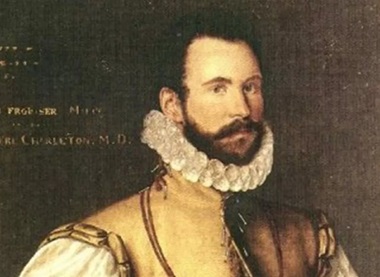
English mariner Martin Frobisher may have celebrated the first Thanksgiving – in Canada. The Pilgrims might disagree. And Australians don’t celebrate the holiday at all. But Thanksgiving can be celebrated every day.
Sing to the Lord with thanksgiving . . . Psalm 147:7
I don’t often have fast food, but on a whim I recently popped into an A&W near the UBC campus. As I sat waiting for my order I noticed a wall decoration with the familiar company logo, and then beneath the large letters, in yellow script, were the names Allen & Wright.
There’s a phenomenon that was popular on social media recently that begins a discovery of something obvious with the phrase: ‘I was today years old when I discovered’ . . . that A&W stood for the names of its founders.
Some of the other ‘discoveries’ that people have made late in their lives include realizing that the division sign (÷) is just a fraction sign with both the denominator and the numerator left blank. Or realizing that a turtle isn’t inside its shell – it actually is its shell.
And as a specialist in the gothic, I was somewhat stunned to discover that the famous ‘American Gothic’ painting by Grant Wood features a father and daughter, not a husband and wife. In this case, though, the story may be a bit more complex. Rumour has it that the model, embarrassed at being mistaken for the wife of a man twice her age, went overboard reassuring everyone it was a father and daughter. The painter never corrected her; nor did he confirm her version of the facts!
Other discoveries: there’s a bear in the mountain face of a Toblerone chocolate bar. The hole in a pasta serving spoon represents the recommended single serving size; the word footage comes from the fact that film was measured in feet. The first episode of a television show is called a pilot because it’s the first time it’s ‘on air’; and you say break a leg to an auditioning actor in the hopes that they end up in a cast. Hold your horses is a pun telling you to be stable.
The truth is, we are surrounded by things that are as plain as the nose on our faces, and that we never see, or perversely misapprehend.
Thanksgiving origins
This certainly happened to me. I was easily in my late teens before I realized that Canadian and American Thanksgivings were on different dates.
That led me to research the origins of the event and I was stunned to read that Martin Frobisher first celebrated Thanksgiving in 1578 on Baffin Island. Not a celebration of a successful harvest as was later the theme, but sheer relief that he had successfully crossed the Atlantic into what would become Canada.
Thanksgiving is also more popularly understood as the celebration of American Pilgrims in 1621, an event that over the years has often been presented as a romanticized celebration of community between Indigenous folk and settlers.
The view from Australia
While Thanksgiving isn’t a holy day of obligation, it was always a part of parish life as I knew it. Then I moved to Australia and a whole bunch of holidays shifted. Father’s Day was in September instead of June. Christmas was celebrated in July, a tradition that arose so that Aussies could have a hot roast dinner in the cooler winter months.
But most surprisingly, Thanksgiving wasn’t really observed. I remember looking on with bemusement as the Australian news service tried to make sense of an American tradition: the presidential pardoning of a turkey, a tradition started by George H.W. Bush.
And I was today years old when I learned that there were reams of documents debating the validity of a papal induct granting permission to eat meat. I had always thought that an induct – or a permission to do something that Church law normally prohibits – had been given by Pope Pius XII in 1958 that allowed American Catholics to eat their leftover turkey on the Friday after Thanksgiving.
It turns out that this is disputed. Some say it was actually Pope John Paul XXIII who issued the decree, others that the induct was permanent, not temporary. Still others insist that this is all just a myth and that no such order was given, at any time, by anyone. The debate is often referred to as the Turkey Induct Controversy, though one critic amusingly referred to it as the Friday Turkey Rehash. To be safe, I have generally just observed the no-meat rule.
I say generally because, looking back at my time in Australia, I recall bemoaning the absence of Thanksgiving and turkey to my parish priest who had himself spent many years in North America.
Every day . . .
He nodded kindly and said, ‘Everyone’s got it wrong any way.’ I waited for the punchline, but when it came, I had to agree. ‘Every day is Thanksgiving. That’s what the eucharist is for. In fact, it’s literally the Greek word for thanksgiving. There is, after all, no greater meal.’ As we walked together towards the church I asked, ‘So can we have a turkey meal anyway?’ He looked at me with something not far from pity: “Not today you can’t. It’s no-meat Friday, and no Thanksgiving Australia!”

Gerry Turcotte
Gerry Turcotte is President of Corpus Christi College and Principal of St. Mark’s College at UBC. He is the author and editor of 20 books including four collections of essays based on his national column in The Catholic Register examining questions of faith and joy.
He was awarded the Governor General’s Award for Canadian Studies in 2011, the Queen’s Diamond Jubilee Medal in 2013 and the Queen’s Platinum Jubilee Medal for services to education and the community in 2023. In 2022 he was granted his Blackfoot name – ‘Mountain Thunder’ – in recognition of his work supporting reconciliation.
He has written this comment as a member of The Bell: Diverse Christian Voices in Vancouver. Go here to see earlier comments in the series.
